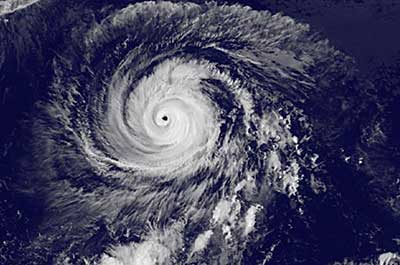GS-1: Important Geophysical Phenomena such as earthquakes, Tsunami, Volcanic activity, cyclone etc. GS3: Disaster and Disaster Management
GS-3: Disaster and Disaster Management
Key phrases: Cyclones, Arabian sea, North Indian ocean
Why in news
Frequency of cyclones has increased in Arabian sea
Analysis:
What is a cyclone?
- Cyclones are rapid inward air circulation around a low-pressure area. The air circulates in an anticlockwise direction in the Northern hemisphere and clockwise in the Southern hemisphere.
- There are two types of cyclones: Tropical cyclones; Extra Tropical cyclones
How are tropical cyclones formed?
- The formation and initial development of a cyclonic storm depends upon the transfer of water vapour and heat from the warm ocean to the overlying air, primarily by evaporation from the sea surface.
- It encourages formation of massive vertical cumulus clouds due to convection with condensation of rising air above the ocean surface.
- When a tropical storm intensifies, the air rises in vigorous thunderstorms and tends to spread out horizontally at the tropopause level. Once air spreads out, a positive pressure at high levels is produced, which accelerates the downward motion of air due to convection.
How are extra-tropical cyclones formed?
- Warm-humid air masses from the tropics meet the dry-cold air masses from the poles and thus a polar front is formed. The cold air mass is denser and heavier and due to this reason, warm air mass is pushed up
- This interaction of cold and warm air masses creates instability and a low pressure is created at the junction particularly in the center of interactions.
- Thus, a void is created because of lessening of pressure. The surrounding air rushed in to occupy this void and coupled with the earth’s rotation a cyclone is formed.
Cyclones and India
- Cyclones constitute 30 percent of all damages caused due to natural disasters in India
- 13 coastal states and UTs in country encompassing 84 coastal districts- Andhra Pradesh, Tamil Nadu, Puducherry, Gujarat, Odisha, West Bengal highly vulnerable -250 million people are exposed to cyclones in these states.
- With a coastline of 7517 km, India is exposed to nearly 10 percent of the world's tropical cyclones.
- A UN report suggests That cyclone frequency will double in India- ADB report suggests India will lose 2 percent of GDP due to natural disasters by 2050.
Why more cyclones in Bay of Bengal than Arabian sea?
- Arabian Sea is comparatively less prone to cyclonic storms than the Bay of Bengal due to cold sea surface temperature-usually1 extremely severe cyclone in 4-5 year
- Geographical location causes cyclones to go nowhere but on land.
- Bay of Bengal is more prone to cyclone than Arabian Sea because it gets high sea surface temperature, low vertical shear winds and has enough moisture in middle layers of its atmosphere.
Why is frequency increasing in Arabian sea?
- Cyclone Kyarr and Maha in 2019 where extremely severe on western coast.
- Increased carbon emissions have led to warming up of Arabian Sea waters.
- More enclosed nature of the sea is promoting more evaporation and cloud formation activities.
- Anthropogenic emissions of aerosols have increased six-fold since the 1930s, leading to a weakening of the southwesterly lower-level and easterly upper-level winds that define the monsoonal circulation over the Arabian Sea.
- Indian Ocean Dipole which is an irregular natural oscillation of Sea Surface Temperatures (SSTs) in which the western Indian Ocean becomes alternately warmer and then colder than the eastern part of the ocean-strongest IOD in 60 years.
- Increase in frequency of cyclones over the Arabian Sea has not posed a corresponding increase in the coastal vulnerability along the west coast since most of such cyclones forming over the Arabian Sea were making landfall over the coasts of Oman, Yemen etc. and hence the threat to Gujarat & Maharashtra coasts remains same.
Consequences of cyclone
- Sea water inundations, floods
- Erosion of beaches and embankments
- Communication disruption
Challenges with Cyclone management
- Bare minimum terminal end equipment and communication backup equipment support
- Lack of grass root participation in disaster management to build resilience
- Lack of fully automated and state of art OC at NDMA and MHA with terminal end facilities and communication connectivity both for routine and disaster
- Failure of even well engineered structures such as communication and transmission after cyclone
What is India doing for it?
- India Meteorological Department announced to launch a dynamic, impact-based cyclone warning system - it will use meteorological data in combination with geospatial and population data to assess the impact of the cyclone in a particular area
- Sagar vani by INCOIS to disseminate info to fishermen community in local languages
- Government launches GEMINI a portable receiver for fail proof warning to fishermen-effective dissemination of emergency information and communication on Ocean States Forecast and mapping of Potential Fishing Zones
Way ahead
- Early warning system and communication-doppler weather radars can provide a lead time of 3 to 6 hours - Developing local networks for real-time rainfall data collection with a ‘Local Network Cell’ in the IMD.
- Vulnerability analysis-classification of structures as per risk using hazard risk zoning
- Design and Management of Urban Drainage System-Pre-monsoon desilting of all major drains to be completed by March 31 each year - Concept of Rain Gardens to be incorporated in planning for public parks.
- Capacity development, awareness generation-participatory urban flood planning and management involving both local government and community.
Source:The Hindu









